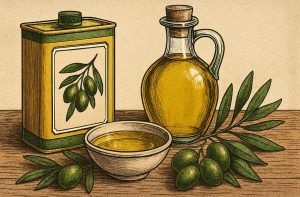If you’ve noticed your favourite bottle of olive oil climbing in price on the supermarket shelves, you’re not imagining it.
Olive oil prices in the UK and across the globe have seen a sharp increase, leaving many consumers wondering what’s causing the sudden surge.
While olive oil is a staple in many kitchens, it’s no longer the affordable option it once was. From extreme weather patterns to supply chain issues, several complex factors are driving up costs.
Understanding these causes can help you make smarter buying decisions and find suitable alternatives when needed.
In this blog, you’ll explore what’s really going on behind the rising prices of olive oil and what it means for your everyday cooking.
What is Olive Oil?

Olive oil is a natural oil extracted from the fruit of the olive tree, primarily cultivated in Mediterranean countries like Spain, Italy, and Greece.
It’s obtained through pressing or centrifugation and is available in several grades, including extra virgin, virgin, and refined olive oil.
Extra virgin olive oil, considered the highest quality, is produced through cold-pressing without using chemicals or heat.
Beyond its culinary appeal, olive oil is rich in antioxidants and healthy fats, especially monounsaturated fats, which contribute to heart health.
It’s often used not only in cooking but also in skincare and haircare routines. Each variety differs in flavour, aroma, and acidity levels, impacting both taste and pricing.
Because of its health benefits and versatility, olive oil remains one of the most sought-after oils worldwide, even amidst increasing costs.
Where Is Olive Oil Most Commonly Used?
You might think olive oil is just for drizzling over salads or preparing Mediterranean dishes, but its versatility extends far beyond that.
In the UK, it is a staple ingredient in many kitchens, used for frying, roasting, baking, and marinating meats and vegetables.
Its ability to enhance flavour without overpowering other ingredients makes it a popular choice for home cooks and chefs alike.
Beyond cooking, olive oil plays a significant role in personal care routines due to its hydrating and anti-inflammatory properties.
Many people incorporate it into:
- Skincare: Used in moisturisers, lip balms, and body lotions for deep nourishment.
- Haircare: Found in hair masks and treatments to improve shine and reduce frizz.
- Oral hygiene: Some use it for oil pulling, a traditional practice believed to improve gum health.
With such diverse applications, the demand for olive oil continues to grow, further impacting its supply chain and increasing market prices.
Why is Olive Oil So Expensive?
The soaring cost of olive oil isn’t just a temporary fluctuation—it’s the result of multiple global factors affecting both supply and demand.
From extreme weather to rising production costs, several challenges have contributed to the price surge.
Key Reasons Behind the Rising Costs
- Drought in major producing countries: Spain, which supplies over 40% of the world’s olive oil, has faced its worst drought in decades, drastically reducing harvests.
- Climate change effects: Rising temperatures, erratic rainfall, and an increase in pests have weakened olive tree health, leading to lower yields.
- Supply and demand imbalance: While production has dropped, global demand, especially for extra virgin olive oil remains high, further driving up costs.
- Inflation and transportation costs: Higher expenses for bottling, shipping, and energy have significantly increased the final retail price.
- Geopolitical instability: Disruptions in shipping routes and economic uncertainties have further strained the global supply chain.
With these challenges compounding, the price of olive oil is unlikely to drop soon, making it an increasingly expensive household essential.
How Much is Olive Oil in 2025?

Olive oil prices in 2025 have surged across the UK, placing strain on household budgets. A 500ml bottle of extra virgin olive oil, once affordable at £3.50, now typically sells for £6.50 to £8.
Premium organic options and oils sourced from single-origin farms have jumped to over £12. These prices are reflective of reduced olive harvests in major producing countries like Spain, Italy, and Greece, primarily due to drought and heatwaves.
The rise isn’t just at the retail level. Wholesale prices have climbed significantly, pushing up costs for restaurants, delis, and food manufacturers.
Post-Brexit tariffs and logistical hurdles have only compounded the pricing pressure, as importing goods into the UK now involves more bureaucracy and higher costs.
With limited supply, higher demand, and ongoing economic pressures, it’s clear that olive oil is no longer the budget-friendly essential it used to be. Consumers will need to adapt their buying habits accordingly.
Will Olive Oil Prices Go Back Down Again?
While it’s natural to hope for price relief, experts say that a quick drop in olive oil prices is unlikely. Olive oil production is deeply dependent on weather patterns, and the droughts of recent years have significantly weakened harvests across Europe.
Even if 2025 sees better growing conditions, olive trees take time, often years, to recover and bear quality fruit again. So, any bounce-back in supply will be gradual, not immediate.
Moreover, global warming continues to shift climate patterns, making traditional olive-growing regions less predictable.
As costs rise to adapt to new growing practices or relocate groves to more temperate areas, those expenses will feed back into pricing.
Some analysts predict slight relief by late 2025 or 2026 if yields improve, but no significant drop is expected this year.
In the meantime, consumers like you may want to explore alternatives, buy smarter, or adjust usage until market stability returns.
How Do Global Supply Chain Disruptions Impact UK Olive Oil Prices?

You may not realise how much international logistics influence the price of olive oil you see on UK shelves. But in 2025, ongoing supply chain disruptions are one of the key reasons you’re paying more.
What Significant Factors are at Play?
- Post-Brexit red tape has introduced new import fees and customs delays when shipping olive oil from Europe to the UK.
- Transport and fuel price increases mean that moving goods from farms to stores costs significantly more than before.
- Container shortages and port congestion have slowed delivery times and increased global shipping charges.
- Labour shortages in both the agriculture and transport industries have led to inefficiencies and delays across the board.
Even if olive oil production improves, these structural issues in the supply chain will continue to affect pricing.
The UK’s reliance on imports for olive oil means any global disruption directly affects what you pay at the till.
Is There a Risk of Fake or Diluted Olive Oil Due to Rising Prices?
As olive oil prices continue to soar, the risk of counterfeit or adulterated products is on the rise. Some suppliers, particularly in regions hit hardest by low harvest yields, may resort to blending premium oils with cheaper vegetable oils to keep costs down and supply up.
While labelled as “extra virgin,” not all products meet the strict standards required. This could lead to a misleading or even nutritionally inferior product ending up in your kitchen.
To protect yourself, always opt for well-known, reputable brands that provide full transparency.
Look for certified labels such as PDO (Protected Designation of Origin) or PGI (Protected Geographical Indication), which confirm quality and traceability.
A trusted bottle should include the harvest date, country of origin, and processing method.
Ultimately, if the price feels unusually low, it’s likely that the quality has been compromised. Making informed purchases helps ensure that you’re getting genuine, high-quality olive oil.
Where Can You Buy Cheap Olive Oil?

While the olive oil market is experiencing inflation, there are still ways to shop smart and keep costs down without compromising on quality.
One of the easiest strategies is to buy supermarket own-brand oils, especially from stores like Aldi and Lidl, where value for money is often a priority. These options are generally tested to meet national standards and are ideal for everyday cooking.
You can also find savings by purchasing in bulk through warehouse retailers like Costco or reputable online shops, where the cost per litre is significantly lower.
Keep an eye out for promotional deals, multi-buy offers, or end-of-season clearances, especially around holidays.
Some brands also offer oil blends mixes of olive oil with sunflower or rapeseed—that retain health benefits but are more budget-friendly.
Farmers’ markets and local cooperatives can also offer better value, especially if you bring your own container or buy in larger volumes.
How to Make Smart Choices When Buying Olive Oil in 2025
With rising costs, choosing the right olive oil in 2025 means understanding quality, storage, and usage. Making informed decisions ensures you get the best value without compromising on taste or nutrition.
Key Tips for Buying Olive Oil Wisely
- Check the label carefully: Look for a harvest date, a specific region of origin, and the term “cold-pressed” to ensure you’re getting high-quality, pure olive oil.
- Choose darker glass bottles: These protect the oil from light exposure, which can cause oxidation and spoilage, helping to maintain its freshness and flavour for longer.
- Store it properly: Keep olive oil in a cool, dark place, away from heat and sunlight, to extend its shelf life and prevent it from turning rancid too quickly.
- Know your usage: Use premium extra virgin olive oil for salads, drizzling, and dipping, while standard or refined olive oil is better suited for frying, roasting, and baking.
- Avoid suspiciously cheap options: Extremely low-cost olive oils may be diluted with lower-quality oils, reducing their health benefits and affecting both taste and nutritional value.
By staying informed, you can balance cost, authenticity, and functionality, ensuring your investment enhances your meals rather than just increasing your grocery bill.
What Are the Best Alternatives for Olive Oil in 2025?

If olive oil prices feel overwhelming, there are excellent substitutes that maintain flavour and health benefits. Exploring different oils helps adjust to rising costs while preserving quality.
Top Olive Oil Alternatives
- Rapeseed oil (canola): A budget-friendly oil with a neutral taste, making it ideal for frying, roasting, and baking without overpowering the flavours of your food.
- Sunflower oil: A widely available and cost-effective option with a high smoke point, making it great for deep-frying, sautéing, and even light dressings.
- Avocado oil: A nutrient-rich oil packed with heart-healthy monounsaturated fats, ideal for high-heat cooking, but it tends to be more expensive than other alternatives.
- Vegetable oil blends: A combination of olive oil and other oils like sunflower or canola, offering a balance between nutrition, affordability, and versatility in cooking.
- Ghee or clarified butter: A flavourful, shelf-stable option that adds a rich, nutty taste to dishes, especially in Indian, Middle Eastern, and Mediterranean cuisines.
While no alternative perfectly replicates olive oil, rotating oils based on cooking needs helps maintain quality and nutrition. Making strategic choices ensures you cook efficiently without overspending.
Conclusion
As olive oil prices continue to climb in 2025, understanding the reasons behind the rise can help you navigate your choices more confidently.
From extreme weather in producing countries to supply chain disruptions and increasing fraud, the olive oil market is facing multifaceted challenges.
However, by staying informed, buying wisely, and exploring alternatives, you can still enjoy this kitchen staple without overspending.
The situation may improve in the future, but for now, making smart, value-driven decisions is the best approach for both your wallet and your wellness.
FAQs About Why is Olive Oil So Expensive
Is the current olive oil price crisis temporary or long-term?
The crisis is likely to persist through 2025 and possibly into 2026, with gradual recovery depending on future harvests and climate conditions.
How much olive oil does the average UK household consume annually?
On average, UK households consume around 1.5 to 2 litres of olive oil annually, depending on cooking habits and household size.
Are supermarket own-brands a good alternative to premium olive oils?
Yes, many supermarket brands offer good quality olive oils at lower prices, especially for everyday cooking.
What countries produce the cheapest olive oil in 2025?
Tunisia, Turkey, and Morocco are among the countries producing more affordable olive oils due to lower production costs.
Can buying olive oil in bulk save you money over time?
Yes, purchasing in bulk usually reduces cost per litre, especially when buying from wholesale or online retailers.
Is there a difference in taste between expensive and cheaper olive oils?
Expensive olive oils often have a richer, more complex flavour profile due to their freshness and production methods.
How is olive oil graded and priced globally?
Olive oil is graded by its acidity, flavour, and processing method, which significantly impacts its pricing in global markets.






